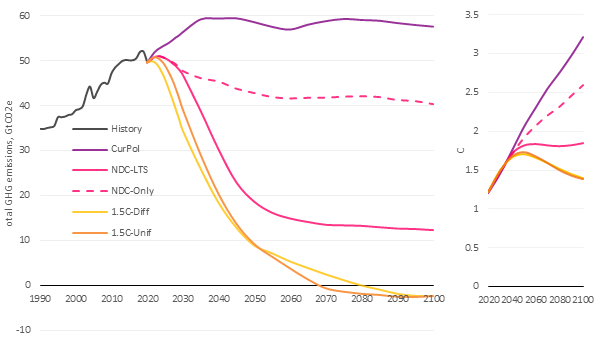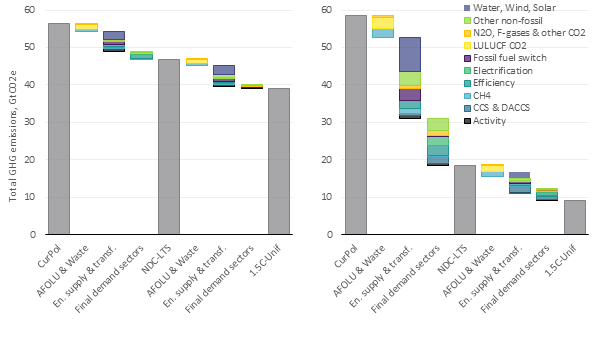The Global Energy and Climate Outlook (GECO) 2021 takes stock of recent updates of national climate targets taking into account nationally determined contributions (NDCs) and national long-term net zero strategies. The report presents an in-depth analysis of global decarbonisation scenarios, with a detailed look on G20 countries, which have accounted for more than 75% of global GHG emissions since 1990.
For each of the G20 countries, the GECO 2021 assesses greenhouse gas (GHG) emissions scenarios for (i) current policies, (ii) announced national climate targets and (iii) global 1.5 °C pathways. Abatement options required to bring current national policies in line with ambitious climate policy targets are presented by sector and activity.
Delivering on long-term net zero emission targets would result in a temperature increase of about 1.8 °C by the end of the century. However, strong policy action is needed. Current policies may lead to a temperature increase of more than 3 °C; substantial additional efforts are still required to keep the temperature increase below 2°C and to reach the 1.5 °C goal of the Paris Agreement.
GECO 2021 - Energy, Greenhouse gas and Air pollutant emissions balances
Projections with an energy-emissions model - using common socio-economic assumptions
GECO 2021 - Macro-economic Baseline
Economic Multi-Regional Input-Output tables
The 2 °C target is within reach, with more net-zero emission pledges
The 2015 Paris Agreement establishes a policy framework in which countries submit their domestic targets to the United Nations Framework Convention on Climate Change (UNFCCC). Countries are invited to revisit these targets every 5 years – with the aim of ratcheting up the level of emission reductions. The first update of NDCs was scheduled ahead of COP 26 in Glasgow and many countries have indeed updated their NDCs, although not all of the updates have increased ambition; submissions up to 05 November 2021 and pledges made in COP26 are included in this report.
The Paris Agreement further invites parties to submit long-term low GHG emission development strategies (LTS). In its long-term strategy of 2018, the EU announced the target to become climate neutral by 2050. Since then, several other large economies have followed and announced their own net-zero emission targets for mid-century.
The announced targets for the short-term (2030) and long-term (mid-century) would mean a clear departure from historic trends and current policies. While current policies may lead to climate change in excess of 3 °C, the implied temperature change from announced targets would amount to about 1.8°C by 2100. This is significantly lower than assessed in previous editions of GECO, as for the first time we include long-term targets together with the NDC targets. Achieving these targets will however require additional policies measures, as current policies are only sufficient to stabilize global emissions by 2035-2040.
Further, to limit global warming to 1.5 °C, more ambitious targets would be needed, both in the short-term for achieving a stronger decline of emissions towards 2030, as well as in the long-term as some major emitters have not yet embraced a net zero target.
Note: The two 1.5 °C scenarios either have a common global carbon price ("1.5C - Unif") or a converging carbon price ("1.5C - Diff"). Both 1.5 °C scenarios were designed to not exceed that temperature change at the end of the century with a probability of 50%.
In the NDC-LTS pathway, emissions would already peak around 2023 and then stabilize by mid-century. Emission reductions in the power sector can contribute most towards realizing the emission targets in the short/medium-term, especially by reducing generation based on coal. Beyond 2030 and moving towards the 1.5 °C target, a reduction of all fossil fuels relative to current levels will be needed to achieve the more ambitious 1.5 °C target.
A detailed look on the G20 countries
This release of GECO provides a detailed view on G20 countries and what the different pathways imply for them.
When zooming in from the global picture to individual countries and regions, it appears that some countries are on track for emission reductions implied by cost-efficient 1.5°C pathways, especially those with net zero emission targets by mid-century. On the other end of the scale are countries with a non-binding NDC target in the short-term and no plan for deep emission reductions in the long-term.
When moving towards the 1.5°C target, all countries reduce the use of fossil fuels, especially coal and decarbonize electricity generation, along with improving energy efficiency, advancing electrification and reducing emissions from land use. However, the mix of abatement options is different for different countries: in terms of overall contribution, the main mitigation options for developed countries are renewables for power generation and demand-side efficiency, while for developing countries the reduction of emissions from land use plays an important role.
Implications for employment transition
The transition to a low carbon economy requires additional investment as the capital stock of the world economy is transformed. Therefore, investment in the overall economy grows at global level under both climate policy scenarios, with the investment in clean power technologies outstanding as the prime driver of this transition. As a consequence, employment levels are positively affected in several sectors, that benefit directly or indirectly from the transition.
Sectors facing the strongest decrease in employment levels, such as the fossil fuel industry, are providing only a small numbers of jobs in the economy even in the absence of climate policy. As the decarbonisation of the economy advances, bioenergy and electrification lead to increased employment opportunities and additional investment positively affects the employment levels in the construction sector.


